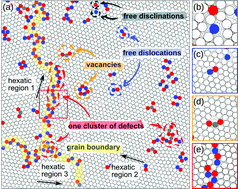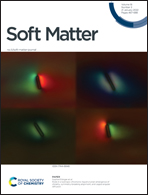Unified analysis of topological defects in 2D systems of active and passive disks
Abstract
We provide a comprehensive quantitative analysis of localized and extended topological defects in the steady state of 2D passive and active repulsive Brownian disk systems. We show that, both in and out-of-equilibrium, the passage from the solid to the hexatic is driven by the unbinding of dislocations, in quantitative agreement with the KTHNY singularity. Instead, extended clusters of defects largely dominate below the solid–hexatic critical line. The latter percolate in the liquid phase very close to the hexatic–liquid transition, both for continuous and discontinuous transitions, in the homogeneous liquid regime. At critical percolation the clusters of defects are fractal with statistical and geometric properties that are independent of the activity and compatible with the universality class of uncorrelated critical percolation. We also characterize the spatial organization of point-like defects and we show that the disclinations are not free, but rather always very near more complex defect structures. At high activity, the bulk of the dense phase generated by Motility-Induced Phase Separation is characterized by a density of point-like defects, and statistics and morphology of defect clusters, set by the amount of activity and not the packing fraction. Hexatic domains within the dense phase are separated by grain-boundaries along which a finite network of topological defects resides, interrupted by gas bubbles in cavitation. This structure is dynamic in the sense that the defect network allows for an unzipping mechanism that leaves free space for gas bubbles to appear, close, and even be released into the dilute phase.



 Please wait while we load your content...
Please wait while we load your content...